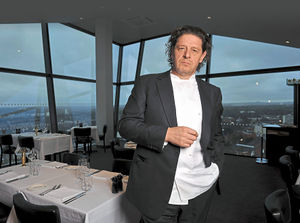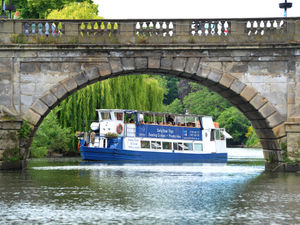Andy Richardson: Has the Michelin star lost its sparkle?
Rewind to 2000 and the region was awash with Michelin stars. Leafy Shropshire was the most important destination in the UK, outside London. It boasted three Michelin starred restaurants and a fourth with a Michelin Bib Gourmand, denoting high standards at a reasonable price.

Birmingham, Staffordshire and the Black Country were relative paupers in comparison. Collectively, they achieved a big fat zero from Michelin. It wasn’t until Simpsons earned a star in 2004 that the Second City got its mojo working.
Fast forward to 2018 and the picture couldn’t be more different. These days, Birmingham is the Second City in every sense. Beaten only by London in the Michelin ratings, it is ahead of Manchester and Liverpool, Cardiff and the North East. Birmingham boasts four stars – one more than Ludlow used to have – and a number of other exceptional, un-starred restaurants. Its food scene is buzzing, it’s markets are as good as any outside London and there’s a real sense of optimism and excitement.
Michelin will announce its stars for 2019 on Tuesday next week (oct 2) when it publishes its annual guide. The big question, however, is this: Have Michelin stars lost their sparkle?
After all, Marco Pierre White, the finest chef of his generation, recently turned down a star for his latest restaurant, which is in Singapore. He said Michelin stars were no longer relevant to his business: “I don’t need Michelin and they don’t need me. They sell tyres and I sell food.”
Closer to home, the last Michelin-starred restaurant in Shropshire and Mid-Wales handed back its award. The Checkers, at Montgomery, decided it wanted to switch from being a starred restaurant offering an evening taster menu to a revamped outlet called Checkers Pantry, only offering lunches.
Checkers head chef Stephane Borie is instead turning to a career as a freelance cook, working for private clients, while his partner, Sarah Francis, will man the kitchens and serve great pastries and delicious lunches. Ms Francis said the decision to hand back their Michelin star was tinged with sadness but it was necessary as they revamped their business.
Chefs are split on the importance of Michelin. Some believe it is a straightjacket and those who earn stars are forced to offer complex tasting menus that define their business. Others continue to view Michelin as the pinnacle of success; a crowning achievement that provides a globally-recognised standard of excellence.
Chris Burt, head chef at the Mytton and Mermaid, in Shrewsbury, says times have changed and while Michelin is hugely important to some, it ought not to be the only criteria guests use when choosing dinners.
He said: “There was probably a time when chefs went hunting for awards and Michelin was top of the list. And there’s no doubt that there are a lot of chefs who still view Michelin as the gold standard.
“But there are also plenty who don’t go chasing awards, who are led by using quality ingredients. Quite often, they can offer more to the everyday customer than Michelin starred restaurants.”
The change in Shropshire has been dramatic. In 2000, Ludlow had three Michelin starred restaurants: Mr Underhills, at Dinham Weir; Hibiscus, at Corve Street; and The Merchant House, at Lower Corve Street. The Oaks, at Corve Street, had a Michelin Bib Gourmand. Others have come and gone – including La Becasse, in Corve Street; The Green Café, at Dinham Weir, and, of course, The Checkers, at Montgomery.
Today, Ludlow has no stars. In comparison, Birmingham had no stars in 2000 and now boasts such starred restaurants as Simpsons, Purnell’s, Adam’s and Carters. Until recently, it had five – with Turner’s, at Harborne, also having a star.
So why the change?
Beth Heath, who organises food festivals across the region, including the popular Shrewsbury Food Festival, says Shropshire has simply changed to meet customer demand, rather than witnessed a diminution of standards.
She said: “Paradoxically, I’d say standards in Shropshire are probably even higher now than they were back in 2000. Okay, so there are no longer the big hitters and the quality at the top end of the market isn’t there anymore. But overall, standards are up. Back in 2000, there were a few good restaurants and a lot that were mediocre. Now you get a lot of high quality mid-priced restaurants offering exceptional food at value prices.
“I think that’s been driven by demand. People don’t necessarily have £75 to spend on a dinner; Shropshire isn’t that sort of county. So businesses have changed so that they meet customers’ needs.
“Birmingham’s a far bigger city with larger businesses and a greater degree of affluence. People have more money to spend and there’s been a concentration of talent there. I think it’s pretty exciting, to be honest.”
While Birmingham restaurants feature the region’s best-known talents, Shropshire is also on the rise. For the first time in some years, three Ludlow restaurants featured in the 2019 Good Food Guide; Mortimers, Fishmore Hall and Old Downton Lodge.
Wayne Smith, chef-patron at Mortimers, said: “I think Ludlow is experiencing a renaissance. We had three restaurants in this year’s Good Food Guide, which is a really important barometer of quality. Times are changing and just because Ludlow doesn’t have any stars doesn’t mean it doesn’t have really high quality right here on the doorstep.”




